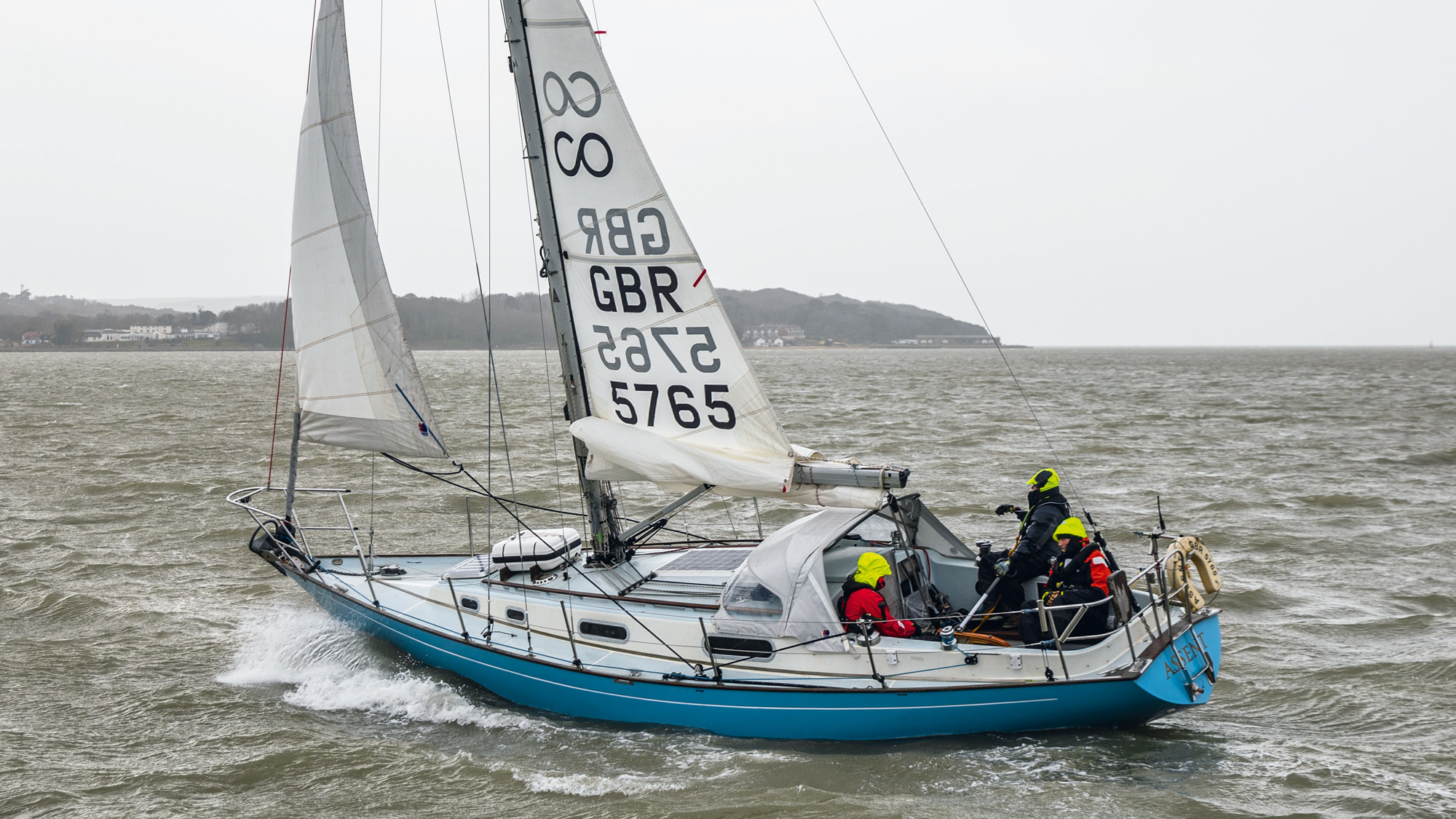The development lately is for newer yachts to have smaller just-overlapping jibs, even non-overlapping self-tacking jibs, with the mainsail space elevated in compensation. Because the introduction of jib furling gear, the overall preliminary response to a rise in wind power has been to drag just a few wraps in on the jib. Now, although, on newer yachts the response to a rise in wind velocity switches to reefing the mainsail, and very often the small jib isn’t furled till three reefs have been put into the mainsail.
Single-line reefing methods are subsequently now the norm on newer yachts. Nonetheless, having one line working from the bottom of the mast, as much as a luff reefing cringle, then again right down to the increase, by way of the increase, then as much as a leech reefing cringle and eventually down and tied off on the increase has one fundamental drawback – friction.
A lot friction on the luff could make it nearly inconceivable to drag the leech cringle out in an effort to tighten the foot and flatten the sail. Various methods embrace pulleys on sliders within the increase, however right here we have a look at what might be completed to enhance the essential system.
On the luff reefing factors, you’ll be able to match swivel-eye ball bearing pulleys (measurement 4 for a 10m yacht). Attempt to receive a design the place the pulley’s wheels are lined on each side to scale back the danger of trapping the sail within the pulley. A further mast slider is inserted into the mast to match every of the reefing cringles. With the pulley on one facet of the sail and a 50mm chrome steel ring on the opposite, they’re mounted along with a skinny Dyneema line from the ring, by way of the sail eye after which to the block. One other line fastens the ring to the brand new mast slider.

Becoming blocks to reefing cringles and altering how the strains are led can massively scale back friction in your reefing system. Picture: Martin Watts
Within the picture above, there may be an additional line from the mast slider to the cringle. Thus, the luff is mounted to the mast while you pressure the foot of the sail. The reefing strains now go up and down on the identical facet of the sail, so the reefing strains will want re-routing.
In case your sail drops in a hard and fast set of folds, then attempt to match the facet the pulleys are on with the folds of the sail.
Decreasing friction on the leech reefing level
For the reef leech pulleys, use light-weight soft-attach or tie-on pulleys (measurement 40mm for a 10m yacht) and safe them to the leech reefing cringles eyes with loops of Dyneema round 20cm lengthy. There are completely different variations of those blocks so make sure you get those with the best breaking masses.
The blocks could have minimal affect on the conventional set of the sail and with appropriate positioning of the increase slider, you’ll be able to obtain good pressure on the foot of the mainsail.

The leech pulley has minimal affect on the sail, due to the longer lashing used. Picture: Martin Watts
Including in a single-line third reefing system
When it’s time to place in a 3rd reef, it can even be a time while you’ll desire to not go away the protection and safety of the cockpit. In case you have a increase with 4 pulleys on the aft finish and two pulleys on high of the increase and two pulleys beneath the increase on the gooseneck finish, then there’s a approach of establishing a single-line reefing system.
Working from the strict, the third reefing line is mounted in the direction of the aft finish of the increase, in an identical method to the opposite reefing strains, working as much as the leech third reef pulley, again right down to the increase finish, by way of the pulley set, and into the increase.
On the entrance of the increase, the road then comes out by way of a turning pulley on the beneath of the increase, spherical a brand new turning block plus becket positioned beneath the increase, then as much as the third luff reefing level, down by way of a reefing result in the mast foot in a standard method.
Article continues beneath…
In the event you should not have sufficient pulley attachment factors on the base of the mast run the third reef line and one other reef line by way of a block and fiddle pulley, somewhat than a double pulley as these don’t work when solely loaded on one pulley. You possibly can then run the brand new reefing line by way of an upgraded deck organiser and into one other clutch close to the cockpit.
Within the picture beneath, you’ll be able to see the third reef turning pulley simply beneath the gooseneck and the white/blue rope secures it to the kicker base mast becoming. In order that this pulley doesn’t fall when not beneath load, a bit of shock-cord (white/blue) is mounted to the pulley becket loop, goes by way of a micro-pulley mounted to the mast gooseneck becoming and right down to the mast kicker becoming.

Set the increase slider to get good pressure on the foot of the sail, accommodating the longer strop. Picture: Martin Watts
For the third reef leech level, should you connect the pulley to the sail with a protracted smooth shackle then you’ll be able to disconnect the leech third reef line in mild climate and sheltered waters, stow it specified by the stack pack and so scale back the quantity of rope dropping into the cockpit while you decrease the mainsail.
If you’re ordering a brand new sail with integral pulleys, it could nonetheless be worthwhile having the third leech reefing level as only a cringle for a similar purpose.

A protracted smooth shackle permits the reef to be simply faraway from the sail for mild airs, and reconnected rapidly with out having to re-reeve strains. Picture: Martin Watts
Bettering reffing operation
There are two potential drawback areas when reefing. With the setup described above, the luff pulley is saved away from the increase pulley. Nonetheless, if the pulley is on the pull-down fold of the mainsail, then the pulleys on the luff can come so shut collectively that the strains don’t run easily. The second drawback is overloading the plastic mast sliders inflicting them to interrupt. The answer for each issues is to not decrease the mainsail fully, so it’s value establishing a reefing setup as follows.
On a lightweight wind day, with the boat moored, hoist the primary fully and mark the reefing strains on the clutch and on the entrance and rear of the increase. Doing which means should you moor up with the mainsail reefed, you’ll be able to pull out the reefing strains earlier than your subsequent sail.

It’s value marking the second and third reefing strains for his or her appropriate place when one reef has been pulled in. Picture: Martin Watts
Then decrease the mainsail down in the direction of the primary reef place however cease decreasing the sail with the mast slider close to the reefing level round 5cm above the slider beneath it. Pull the primary reefing line tight and alter the strains to take care of that 5cm hole. Now mark the mast on each side round 1m above the gooseneck reverse a particular level on the sail, similar to a batten automobile and mast slider. It’s also helpful should you pull within the different reefing strains and mark their positions on the clutches. Repeat the process for the opposite reefing factors.
The reefing operation begins with easing the kicker and, if obligatory, tightening the topping carry. Then decrease the mainsail beneath management with one flip of the halyard across the winch, while pulling within the reefing strains. All the time pull the reefing strains in concurrently, in any other case the unfastened leech strains can tangle themselves. Having lowered the sail to the right place in accordance with the mark on the mast, clutch off the halyard after which pull the lively reefing line in tight on the winch.

Having clutched off the lively reefing line, tighten up on the primary halyard the ultimate couple of cms to pressure the luff. Then alter the kicker and the topping carry. On the primary couple of occasions you reef the yacht, verify the mast marks are in the precise place.
On some yachts, you’ll be able to ease the primary halyard while it’s wrapped round a winch on the cockpit coaming, while utilizing the coachroof winch for tensioning the reefing strains.
Newer yachts with their giant mainsails actually profit should you comply with the outdated saying, ‘Put in a reef while you first give it some thought,’ so reef early. Ensuring your reefing system is environment friendly will scale back the variety of occasions you delay placing in a reef as a result of it appears such arduous work.
Loved studying this?
A subscription to Yachting Month-to-month journal prices round 40% lower than the duvet worth, so it can save you cash in comparison with shopping for single points.
Print and digital editions are available through Magazines Direct – where you can also find the latest deals.
YM is full of data that will help you get essentially the most out of your time on the water.
-
-
- Take your seamanship to the subsequent degree with suggestions, recommendation and abilities from our specialists
- Neutral in-depth evaluations of the most recent yachts and gear
- Cruising guides that will help you attain these dream locations
-
Comply with us on Facebook, Twitter and Instagram.

